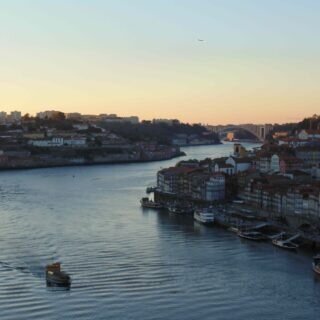Porto owes its scale and existence to the bountiful waters of the Douro river. It is an inherently fluvial and portuary city (as the name indicates), and it grew around a small hill, the Penaventosa Hill, towards the river. As it continued growing, it did so radially, like most cities do when growing organically. However, Porto isn’t merely fluvial these days. At a mere five kilometres from the sea, the city inevitably expanded westwards,following the Douro down to where it meets the Atlantic ocean; this in part due to British businessmen of the city of Porto who considered the sea breeze beneficial to one’s health, and thusly settled there.
The mouth of the river, named Foz in Portuguese as such became one of the many parts that compose the city. Whereas in downtown Porto the bustling and frenetic life of a major city with views drowned under (marvelous) buildings, the Foz is an open, sweeping landscape. With promenades upon the rocky shore, small beaches, tree lined avenues along the sea, coffee shops and bars overlooking the ships scattered across the horizon, coming and going from the Leixões Harbour, in Matosinhos.

The Foz parish was but a little piscatory community which lived off the bounties of the sea, but also from supporting and protecting Porto’s very intense naval activity. A privileged spot for lighthouses, you can find among them the Lighthouse of São Miguel-o-Anjo from the 16th century, and the Felgueiras Lighthouse, from the 19th century, right at the mouth of the river. It was also of a great strategic value, being one of the major ports of the country, and there are two old coastal forts the southern one, the Fortress of Saint John of Foz, from the 16th century, remodeled in the 18th century, and the Fort Saint Francis of Queijo (amusingly nicknamed the Cheese Castle) from the 17th century, to the northern limits of the Foz.


While the historical landmarks are worth visiting and exploring, the seaside avenues and promenades characterize and intrinsically shape this area of the city. At first lined in the south by small old fishermen’s and sailors’ homes, as the avenue of Brazil progresses north its flanks are confused between three floor 19th century constructs, taller flats from the previous one, and sometimes broken up by a mansion. Then ends the Avenue of Brazil, and starts the Avenue of Montevideu, with large opulent mansions overlooking the ocean. For all the architectural confusion born out of a scramble for prime real estate, where Foz finds itself is in its gardens and promenades. Overlooking the sea, these Romantic gardens cascade across the coast until the avenues end. The Homem do Leme (Man of the Helm) statue bravely holds onto the helm of the ship before the raging gray oceans on the windiest and stormiest days the Atlantic throws at him. The orange hue of the setting sun on a clear day virtuously paints the pergolas of the Pérgola garden. Sheltered by trees from the traffic of the avenue, the Ingleses Garden’s (English Garden) lush paths snake around the small cliffside to coffee shops and the beach. Then Passeio Alegre Garden, makes all justice of where the long journey of the Douro river ends. The palm tree lined promenades in what over the last waters of the Douro are backed by the cool, fresh garden, among the most noble ones of the city.

To get there, it is inevitable to suggest one take the first tram line of the city of Porto, Line 1. It takes you from Saint Francis Church, through Miragaia along the riverside, to Passeio Alegre. A popular choice no doubt, and with good reason. If it appears to be too popular a choice at that time, then the 500 STCP bus line from Aliados Avenue also goes along the riverside all the way to Matosinhos, through Foz is a lovely double decker alternative. One thing is certain, however: to leave Porto without experiencing Foz is to have done oneself a great disservice.
Contact us if you want a private tour around Foz!



